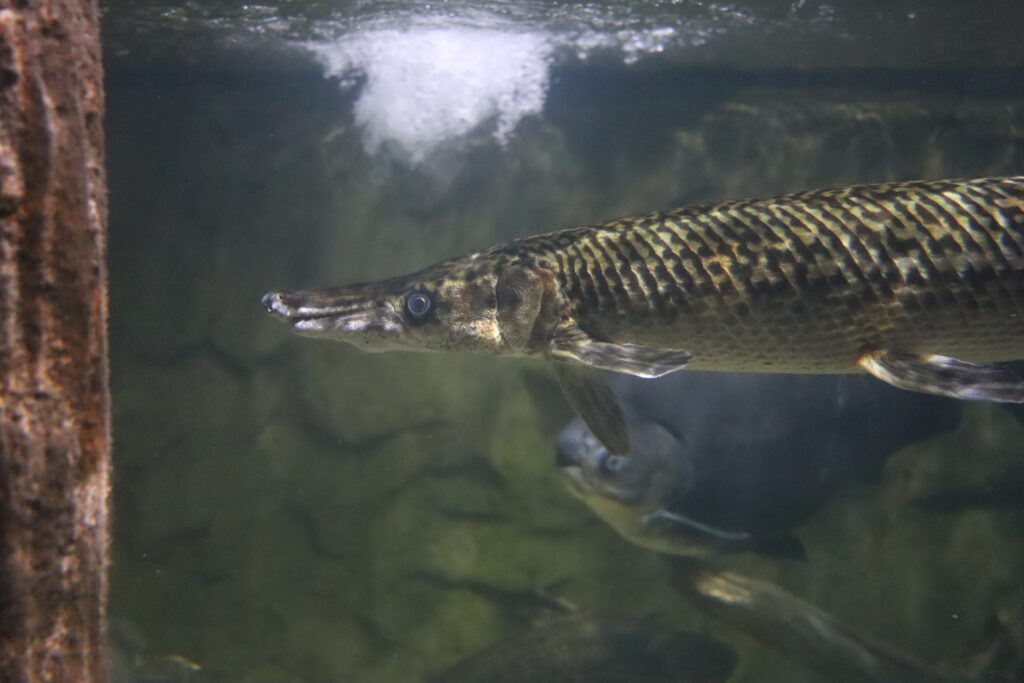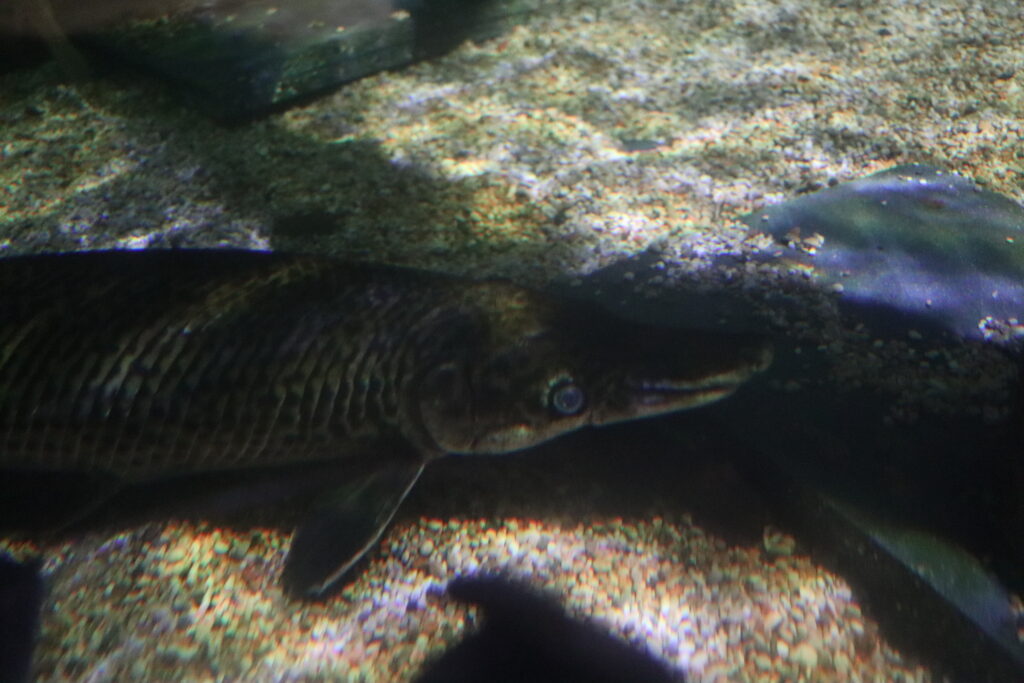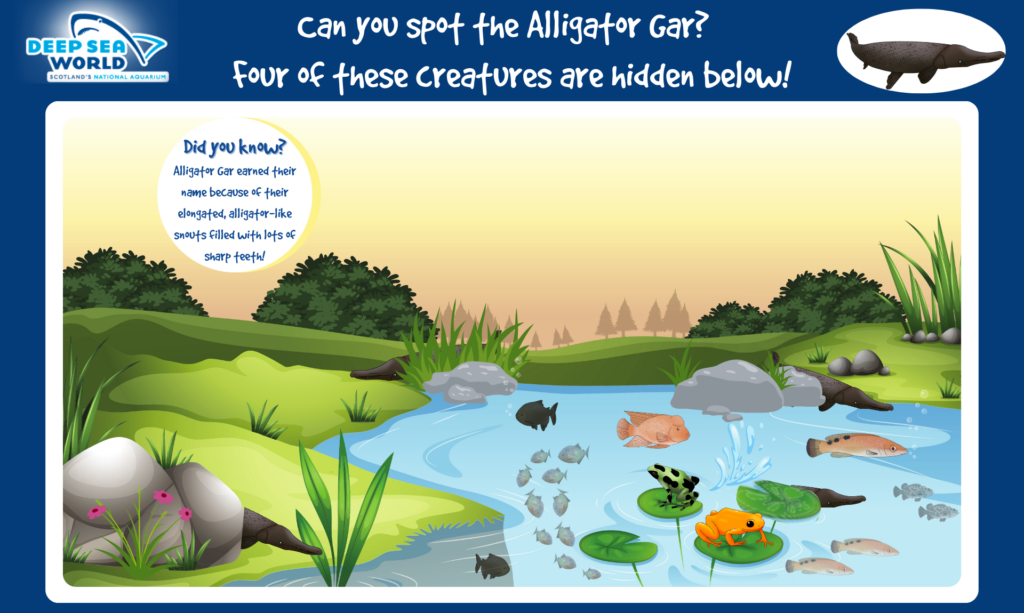You’ll be forgiven for thinking the alligator gar is a type of alligator – but it is in fact a fish, and bears no relation to the reptile. Part of the gar fish family, of which there are seven different species, the alligator gar (Atractosteus spatula) is the largest. So, what is it about these creatures that is so intriguing, and can you spot the hidden alligator gars in our fun visual at the end of the post? Let’s find out!
What is an alligator gar?
The alligator gars are part of an ancient lineage of fish (Lepisosteidae) that dates back to the dinosaur times – 157 million years ago in the late Jurassic period, to be precise. They are known as holosteans, which means ‘whole bone’. The gars and their close relatives the bowfins are part of a group of ray-finned bony fish called Holostei, which are characterised by having more of a skeleton as opposed to being cartilaginous.
Alligator gars get their name from their long slender bodies, long snout and sharp teeth. They also have a similar colour to alligators, with most having grey, green and brown scales with yellow or white underbellies.
Most interesting facts about the alligator gar
So, now you know what an alligator gar actually is, it’s time to dive in and learn a little more about the most fascinating features and behaviours of this species!

You’ll only find alligator gars in the Mississippi
While their prehistoric relatives inhabited many different parts of the world, alligator gars were typically only found in North and Central America, mostly through the Mississippi River Valley. They were also known to live as far reaching as Iowa, Kansas and Nebraska.
Today alligator gars are found only in the Mississippi River Valley and not much further afield. This is because they developed a negative reputation as being a type of ‘trash’ fish, which means anglers believed they damaged fishing nets and ate game fish. This meant the population of alligator gars were culled in many areas, something that is now being reversed as biologists have proven that the species aren’t actually targeting game fish.
Alligator gars can weigh up to 158kg
As mentioned earlier, the alligator gar is the largest out of the 7 species in this family. In fact, this particular fish has been known to weigh as much as 158kg (350lbs) – this is about the same weight as 3 giant pacific octopuses!
They can also grow up to 3 metres long (10ft), which makes them about the same length as an alligator.
They are one of the largest freshwater fish in the world
The weight of the alligator gar makes it the largest freshwater fish species in North America. However, alligator gars do prefer living in the slow-moving pools and backwaters of rivers, swamps and lakes. They can also tolerate brackish and salt water if necessary, making them a very versatile species.

An alligator gar’s eggs are poisonous
While the alligator gar poses no direct threat to humans despite their aggressive appearance, their eggs are poisonous if eaten. This serves as a great defence against predators. The eggs contain ichthyotoxin, which is a toxic compound.
They are camouflaged to better capture their prey
The colouring of alligator gars gives them the ability to camouflage themselves, which isn’t just great for avoiding predators, but also for being able to capture its prey. Alligator gars are primarily piscivores, eating smaller fish, but have been known to eat birds, small mammals, turtles and crabs.
An alligator gar is able to lay still, waiting for fish or other prey to swim by, before lunging forward and lashing their head from side to side. They usually lay at the top of the water, resembling a log thanks to their brown and green colours. See if you can spot our alligator gar in the image at the bottom of this post!
Alligator gars have an air bladder that acts more like a lung
All fish have an air bladder, or swim bladder, which helps them to stay buoyant and can also play a role in respiration. In the case of the alligator gar, their air bladder is thick, spongy and highly vascular, to help it act more like a lung. This means the fish can gulp air to breathe in waters that have a low oxygen content, aerating the alligator gar’s blood.
Can you spot the alligator gar?

You can come and visit our very own alligator gar, Gary, right here at Deep Sea World! He’s part of the Big Fish Campaign, which raises awareness of the problem of aquarium fish growing larger than home aquaria. The campaign hopes to promote better and more responsible buying and selling of these larger species. Buy your tickets to Deep Sea World today and experience a diverse and fascinating array of marine life.
